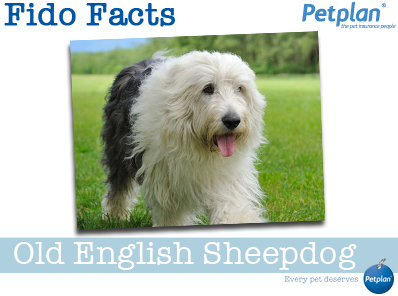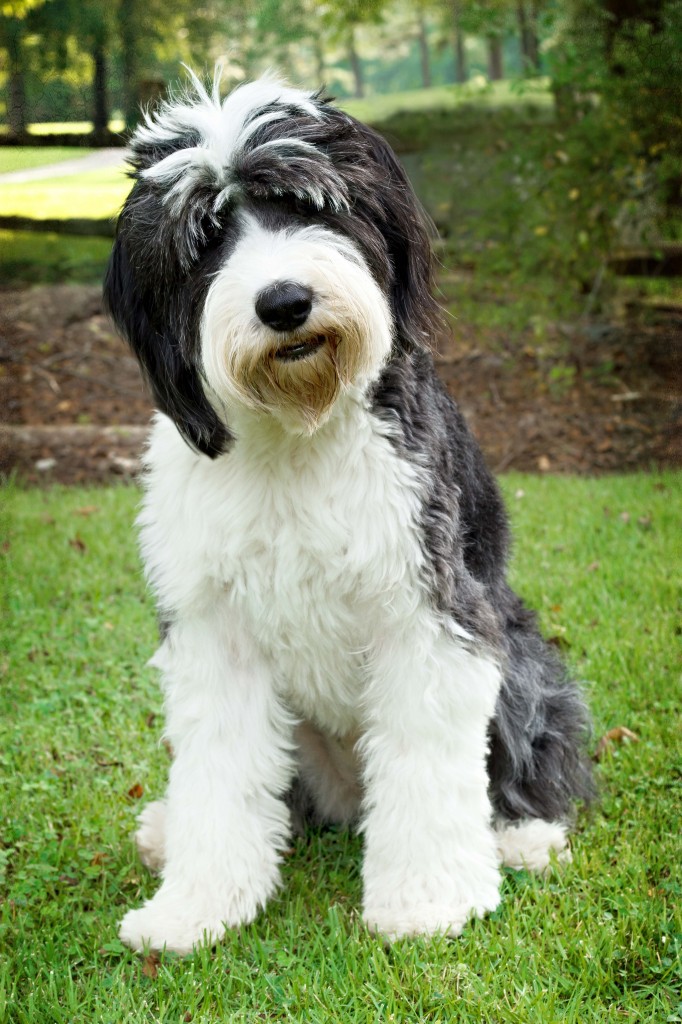
Appearance
The Old English Sheepdog (OES) is most often recognized by it’s shaggy, double coat. The OES’s coat is long with a textured outer coat and a soft, waterproof undercoat. These dogs’ coats come in a variety of colours and colour combinations including gray, grizzle, blue, blue gray, blue merle, gray with white markings or white with gray markings.??Their body is strong with a square, muscular physique and thick, round legs. The OES has a big head with a black nose and it’s medium sized ears are positioned flat to the dog’s head. Eyes could be brown, blue or one of each color.??Males grow to a height of between 56 – 61 cm and females are about 51 cm. OES’s typically weigh between 27 kg and??29 kg; however, some have weighed in at over 45 kg.
The Old English Sheepdog is either born tailless (in which case the OES will be referred to as a bobtail) or in some countries (not Australia) the tail is completely amputated. Note: it is illegal to dock tails in Australia and in most parts of Europe.
Temperament
 The Old English Sheepdog is a happy-go-lucky bundle of joy. Loyal, protective and intelligent, it makes a wonderful animal companion and ??because they are friendly and gentle, the breed is well suited to families with children. The OES is considered a working breed and, as such, can be trained to follow commands very well. ??Unlike other working breeds the OES using ‘bumping’ techniques to herd rather than nipping – because these dogs have a strong herding instinct they need to be taught not to herd humans.??This breed does well with a strong owner and with firm, consistent leadership and the OES??will ignore commands from any??human pack members who they deem to be weaker willed.
The Old English Sheepdog is a happy-go-lucky bundle of joy. Loyal, protective and intelligent, it makes a wonderful animal companion and ??because they are friendly and gentle, the breed is well suited to families with children. The OES is considered a working breed and, as such, can be trained to follow commands very well. ??Unlike other working breeds the OES using ‘bumping’ techniques to herd rather than nipping – because these dogs have a strong herding instinct they need to be taught not to herd humans.??This breed does well with a strong owner and with firm, consistent leadership and the OES??will ignore commands from any??human pack members who they deem to be weaker willed.
Origin
The Old English Sheepdog was developed in England by farmers requiring a canine worker to herd sheep and drive cattle when they would take their animals to market. The dogs became widely used in agricultural areas. It was during the 1840-70???s that the OES was introduced to Australia. These dogs accompanied emigrant farm workers that were encouraged to migrate from Great Britain to seek a better life and help establish a sheep industry on the pastures west of the Great Dividing Range. By the 1900s the Kelpie (read about the Kelpie by clicking here) had become Australia’s premier herding dog and the OES’s presence in Australia diminished. In the 1960’s the breeds popularity began to increase again, but this time, in show circles and a specialist club was formed for the breed.
Fun Facts
- Why a docked tail? Farmers began the practice of docking the tails in the 18th century as a way of identifying the dogs that were used for working so they could get a tax exemption. This is why the OES has the nickname “bobtail”.
- The bark of the Old English Sheepdog sounds like a cracked bell.
Advice to Owners
This breed remains puppy-like for many years, and age tends to hit it suddenly. For most of the dog’s life it will be full of energy!??Like all working breeds, these dogs need to be taken on a walk??or run.??It is best to make the dog heel beside or behind the person holding the lead so that the dog understands that the leader is the human.The average Old English Sheepdog lives for about 10-12 years
This Blog was written by the furry family at??Petplan Australasia. Petplan Pet Insurance specialises in animal and animal industry insurance. Our practices keep the role that pet insurance plays in responsible pet ownership and the health of the pet at the forefront. For tips to keep your pet healthy, make sure you follow us on??Facebook.




